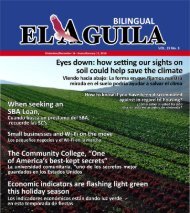El Aguila Magazine – October 13, 2016
Create successful ePaper yourself
Turn your PDF publications into a flip-book with our unique Google optimized e-Paper software.
<strong>El</strong> <strong>Aguila</strong> Octubre/<strong>October</strong> <strong>13</strong> - Noviembre/November 15, <strong>2016</strong><br />
SALUD/HEALTH<br />
7<br />
Diez maneras que los hispanos pueden prevenir la diabetes<br />
<strong>El</strong> Programa Nacional de<br />
Educación sobre la Diabetes<br />
(NDEP, por sus siglas<br />
en inglés) recomienda a las personas<br />
con alto riesgo de diabetes<br />
tipo 2 que tomen unos pasos<br />
pequeños para reducir la probabilidad<br />
de desarrollar diabetes<br />
y los problemas graves de salud<br />
que son causados por la diabetes,<br />
como las enfermedades del corazón,<br />
los ataques al cerebro, las<br />
enfermedades de los riñones, la<br />
Ten ways Hispanics can prevent<br />
type 2 diabetes<br />
The National Diabetes Education<br />
Program (NDEP)<br />
is urging people at high<br />
risk for type 2 diabetes to take<br />
small steps to lower their chances<br />
of getting diabetes and serious<br />
health problems caused by diabetes<br />
such as heart disease, stroke,<br />
kidney disease, blindness, and<br />
nerve damage.<br />
Take the first step today by asking<br />
your health care team if you are at<br />
risk for type 2 diabetes or prediabetes.<br />
Before a person develops<br />
type 2 diabetes, they usually have<br />
prediabetes, which means their<br />
blood sugar (blood glucose) levels<br />
are higher than normal, but<br />
not yet high enough to be called<br />
diabetes.<br />
Hispanics and Latinos are at high<br />
risk for type 2 diabetes, but there<br />
is good news. You can prevent or<br />
delay type 2 diabetes by making<br />
small lifestyle changes around<br />
what you eat and how you stay<br />
physically active. Here are some<br />
tips to help you:<br />
1.Set goals you can meet and<br />
start by making small changes.<br />
First, set a goal you can achieve.<br />
Add one or two healthy changes<br />
every week.<br />
2.For support, team up with<br />
friends and family to help you<br />
lower your risk for type 2 diabetes.<br />
Ask your family and friends<br />
to help you stick to your program.<br />
Prepare healthy meals together<br />
and find ways to be more active<br />
with your family, such as walking,<br />
shooting hoops, or sharing<br />
some of the household chores.<br />
ceguera y el daño a los nervios.<br />
Tome el primer paso hoy. Pregúntele<br />
a su médico o a alguien de su<br />
equipo de cuidados de la salud si<br />
usted corre riesgo de desarrollar<br />
la diabetes tipo 2 o la prediabetes.<br />
Antes de que una persona desarrolla<br />
la diabetes tipo 2, por lo<br />
general tiene prediabetes, lo que<br />
significa que sus niveles de azúcar<br />
en la sangre (glucosa sanguínea)<br />
son más altos de lo normal,<br />
3.If you are overweight, try to<br />
lose at least 5 to 7 percent of<br />
your current weight <strong>–</strong> that’s 10<br />
to 14 pounds for a 200-pound<br />
person. An important way to prevent<br />
or delay type 2 diabetes is<br />
to lose weight by making healthy<br />
food choices and being physically<br />
active. Try to lose weight<br />
by getting at least 30 minutes of<br />
physical activity a day, five days<br />
a week and eating foods lower in<br />
calories and fat.<br />
4.Make healthy food choices<br />
every day. Start with small changes,<br />
such as eating brown rice<br />
instead of white rice, or drinking<br />
low-fat or fat-free milk instead of<br />
whole milk. Choose foods that<br />
have lots of fiber such as fresh<br />
fruits and vegetables from every<br />
color of the rainbow—red, orange,<br />
yellow, white, green, blue,<br />
and purple. A southwestern salad<br />
topped with tomatoes, low-fat<br />
cheese, black beans, corn, grilled<br />
chicken, and low-fat or fat-free<br />
sour cream can be a good choice.<br />
5.Make time to prepare and cook<br />
healthy foods. Cook with less oil<br />
and butter. Broil or bake with<br />
non-stick spray or low-sodium<br />
broth instead. Use herbs and seasonings<br />
to add flavor to low-fat<br />
dishes. Instead of salt, give foods<br />
a little kick by adding hot sauce<br />
or red pepper flakes.<br />
6.Cut down on food portion sizes.<br />
The portion size that you are<br />
used to eating may be more than<br />
a standard serving size, so you<br />
might be eating more calories and<br />
fat than you think. Use a smaller<br />
plate to help control your portion<br />
pero no lo suficientemente altos<br />
como para ser diabetes.<br />
Los hispanos y los latinos tienen<br />
un alto riesgo de desarrollar diabetes<br />
tipo 2. Pero la buena noticia<br />
es que se puede prevenir o retrasar<br />
la diabetes tipo 2 haciendo pequeños<br />
cambios al estilo de vida en<br />
los alimentos que come y en la actividad<br />
física que hace. Estos son<br />
algunos consejos que le pueden<br />
ayudar:<br />
sizes. If you are going to have<br />
dessert, share it.<br />
7.Choose water to drink instead<br />
of juice and regular soda. Find a<br />
water bottle you really like, such<br />
as one that promotes your favorite<br />
sports team, and drink water from<br />
it wherever and whenever you<br />
can. Limit or avoid sugar in your<br />
coffee or tea.<br />
8.Increase your activity level by<br />
walking more often. Plan walking<br />
dates with friends or family<br />
members throughout the week.<br />
Organize a walking group with<br />
your neighbors or co-workers.<br />
Take your dog <strong>–</strong> or a friend’s dog<br />
<strong>–</strong> for a brisk walk.<br />
9.Get active every day. Pick an<br />
activity you enjoy that will keep<br />
you moving, such as soccer, bike<br />
riding, or swimming. Dance to<br />
your favorite music. Take the<br />
stairs instead of the elevator to<br />
your office. Deliver a message in<br />
person to a co-worker instead of<br />
sending an email.<br />
10.For more ways to lower your<br />
risk for type 2 diabetes, check<br />
out NDEP’s free resources in<br />
English and Spanish. Order<br />
NDEP’s Mi plan de acción para<br />
prevenir la diabetes tipo 2 or the<br />
bilingual Prevengamos la diabetes<br />
tipo 2: Paso a Paso tip sheet by calling<br />
1-888-693-NDEP (1-888-693-<br />
6337), TTY: 1-866-569-1162 or<br />
visithttps://catalog.niddk.nih.gov/<br />
ndep.cfm.External NIDDK Link<br />
Source: National Institute of Diabetes<br />
and Digestive and Kidney<br />
Diseases(NIH)<br />
1.Fije metas que pueda alcanzar<br />
y comience haciendo cambios<br />
pequeños. En primer lugar,<br />
fíjese una meta que pueda lograr.<br />
Añada uno o dos cambios<br />
saludables cada semana.<br />
2.Busque apoyo juntándose<br />
con amigos y familiares que le<br />
ayuden a reducir su riesgo de<br />
diabetes tipo 2. Pídale a su familia<br />
y amigos que le ayuden a<br />
cumplir con su programa. Preparen<br />
juntos comidas saludables<br />
y busquen maneras de ser más<br />
activos en familia, haciendo actividades<br />
como caminar, jugar<br />
básquetbol, o compartir algunas<br />
tareas del hogar.<br />
3.Si usted tiene sobrepeso, trate<br />
de perder al menos del 5 al<br />
7 por ciento de su peso actual.<br />
Eso quiere decir, unas 10 a 14<br />
libras (de 4.5 a 6.5 kilos) para<br />
una persona que pesa 200 libras<br />
(unos 91 kilos). Una manera importante<br />
de prevenir o retrasar la<br />
diabetes tipo 2 es bajar de peso<br />
comiendo alimentos saludables<br />
y haciendo actividad física. Trate<br />
de bajar de peso haciendo por<br />
lo menos 30 minutos de actividad<br />
física al día, cinco días a la<br />
semana y comiendo alimentos<br />
bajos en calorías y grasa.<br />
4.<strong>El</strong>ija alimentos saludables todos<br />
los días. Comience con cambios<br />
pequeños, como comiendo<br />
arroz integral en lugar de arroz<br />
blanco, o tomando leche baja en<br />
grasa o sin grasa en lugar de leche<br />
entera. <strong>El</strong>ija alimentos que<br />
tengan mucha fibra, como frutas<br />
y verduras frescas de todos los<br />
colores del arco iris: rojo, naranja,<br />
amarillo, blanco, verde, azul<br />
y morado. Una buena opción<br />
puede ser una ensalada al estilo<br />
del suroeste de los Estados Unidos,<br />
que lleve tomates, queso<br />
bajo en grasa, frijoles negros,<br />
maíz, pollo a la parrilla, y crema<br />
agria baja en grasa o sin grasa.<br />
5.Busque el tiempo para preparar<br />
y cocinar comidas saludables.<br />
Cocine con menos aceite y<br />
mantequilla. Mejor, prepare las<br />
comidas a la parrilla o al horno<br />
con aceite en aerosol de cocina<br />
o caldo bajo en sodio. Use hierbas<br />
y condimentos para darle sabor<br />
a los platillos bajos en grasa.<br />
En lugar de sal, dele más sabor<br />
a los alimentos añadiendo salsa<br />
picante o chile (ají) triturado.<br />
6.Reduzca el tamaño de las porciones<br />
de los alimentos. <strong>El</strong> tamaño<br />
de la porción que usted está<br />
acostumbrado a comer puede ser<br />
más que el tamaño de una porción<br />
estándar, por lo que podría estar<br />
comiendo más calorías y grasa de<br />
lo que piensa. Use un plato más<br />
pequeño para ayudar a controlar<br />
el tamaño de las porciones. Si va a<br />
comer postre, compártalo.<br />
7.Escoja agua para beber en lugar<br />
de jugo o soda regular. Busque<br />
una botella de agua que realmente<br />
le guste, como por ejemplo,<br />
una con el nombre de su equipo<br />
deportivo favorito, y beba agua de<br />
esa botella siempre que pueda. Limite<br />
o evite el azúcar en su café<br />
o té.<br />
8.Para aumentar la cantidad de<br />
actividad física que hace, camine<br />
más a menudo. Invite a sus amigos<br />
o familiares a caminar durante<br />
la semana. Organice un grupo con<br />
sus vecinos o compañeros de trabajo<br />
para salir a caminar. Lleve a<br />
su perro, o al perro de un amigo, a<br />
caminar rápido.<br />
9.Manténgase activo todos los<br />
días. Escoja una actividad que le<br />
guste y que le mantenga en movimiento,<br />
como el fútbol, andar en<br />
bicicleta o nadar. Baile al ritmo de<br />
su música favorita. Suba por las escaleras<br />
en lugar del ascensor hasta<br />
su oficina. Si necesita decirle algo<br />
a un compañero de trabajo, dele<br />
el mensaje en persona en lugar de<br />
enviar un correo electrónico. Para<br />
obtener más consejos sobre cómo<br />
hacer más actividad física, mire<br />
los recursos disponibles en la biblioteca<br />
en línea del NDEP Diabetes<br />
HealthSenseExternal NIDDK<br />
Link.<br />
10.Para aprender más maneras<br />
de reducir su riesgo de la diabetes<br />
tipo 2, vea los recursos gratuitos<br />
del NDEP en inglés y en español.<br />
Pida Mi plan de acción para prevenir<br />
la diabetes tipo 2 o la hoja<br />
de consejos bilingüePrevengamos<br />
la diabetes tipo 2: Paso a Paso<br />
llamando al 1-888-693-6337 (1-<br />
888-693-NDEP), TTY: 1-866-569-<br />
1162 o visitando https://catalog.<br />
niddk.nih.gov/ndep.cfm.External<br />
NIDDK Link<br />
Fuente: National Institute of Diabetes<br />
and Digestive and Kidney<br />
Diseases(NIH)
















